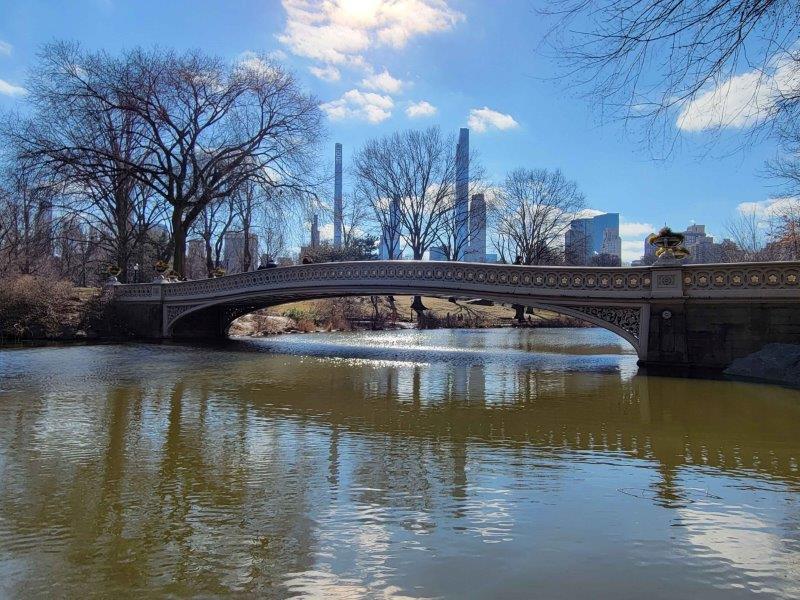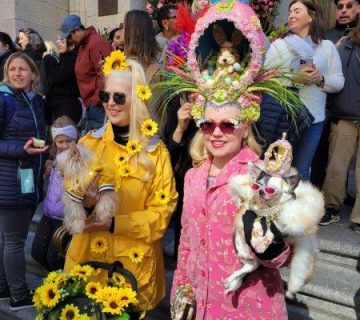Central Park is an iconic urban park located in the heart of Manhattan, New York City. The park spans 843 acres and offers a wide range of activities and attractions for visitors of all ages throughout the year. It is popular with New Yorkers and visitors alike, with 42 million people visiting it annually. In fact New Yorkers like me that live in apartments with no outdoor space actually consider Central Park to be our backyard, and we spend an immesurable amount of time to soak in the greenery there, especially over weekends.
Central Park was designed by Frederick Law Olmsted and Calvert Vaux in the mid-19th century and was the first landscaped public park in the United States. The park is home to numerous lakes, gardens, and recreational facilities, including the Central Park Conservatory Garden, the Wollman Rink, and the Central Park Tennis Center. Visitors can also take a stroll through the Ramble, a wooded area in the center of the park that is home to over 210 species of birds.
Central Park is an iconic symbol of New York City, and has been featured in countless films and TV shows over the years. It offers a place to relax and unwind, or to explore many of its landmarks and activities that it has to offer.
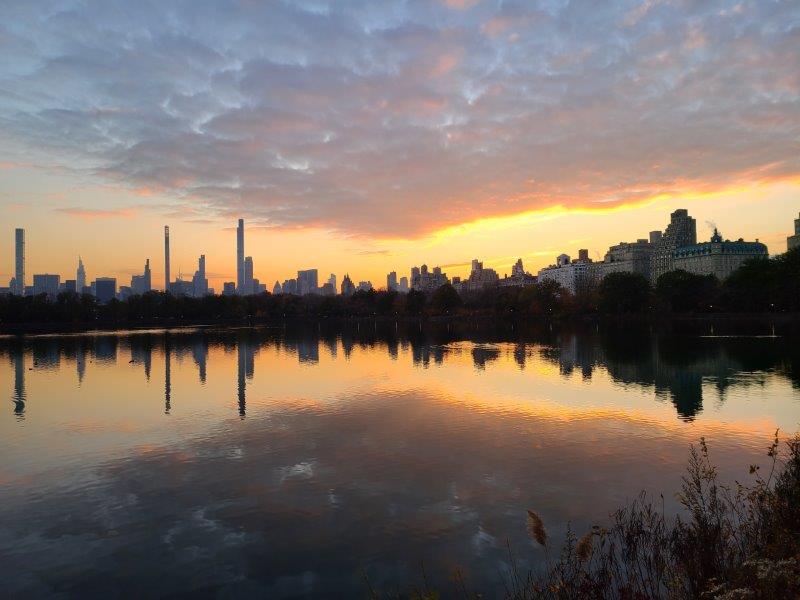
Table of Contents
History
Origins
Central Park is a public park located in the heart of Manhattan, New York City. The park was designed by Frederick Law Olmsted and Calvert Vaux, who won a design competition to build Central Park, and was opened to the public in 1858. The park was created in response to the growing need for open spaces in the city, as the population was rapidly increasing. The park spans over 843 acres and is home to many attractions such as the Central Park Zoo, the Great Lawn, and the Central Park Conservatory Garden. The park’s design features a mix of natural and man-made elements, including lakes, ponds, hills, and meadows.
The amazing part of the Central Park design is that it enables cross town traffic through a system of transverse roads, but at the same time makes the park feel like one expanse that can be navigated without encountering the crosstown traffic while you are in the park.

Development
The development of Central Park was a massive undertaking that took several years to complete. The park was built on swampland and rocky terrain, which made it a challenging project. The construction of the park began in 1857, parts of the park were opened to the public in 1858, and its construction was completed in 1873. In this period, laborers shifted almost 5 million cubic yards of earth, erected 36 bridges and arches, and assembled 11 overpasses across the transverse roads. Additionally, they planted 500,000 trees, shrubs, and vines, creating manmade landscapes entirely crafted by hand.
Modern Era
After a period of decline in the early 20th century, New York City parks commissioner Robert Moses started a program to clean up Central Park in the 1930s. The park underwent a major renovation, which included the restoration of many of the park’s original features, and to build new ones like Woolman Rink.
Today, Central Park is one of the most visited parks in the world, attracting over 42 million visitors annually. The park is a popular destination for tourists and locals alike, offering a variety of activities such as boating, ice-skating, and concerts.
Geography
Location and Access
Central Park is located in the heart of Manhattan, New York City. It stretches from 59th Street to 110th Street and from Fifth Avenue to Eighth Avenue, which is called Central Park West for the length of the park. The park is easily accessible by public transportation, with multiple subway and bus routes stopping near its entrances. Visitors can also access the park by car, bike, or on foot.

Central Park Loop
The Central Park Loop is a popular 6.1-mile running and biking path that circles the entire park. The loop is mostly flat and offers scenic views of the park’s landscape, including the Jacqueline Kennedy Onassis Reservoir and the Great Lawn. The loop is also a popular spot for rollerblading and walking.
Size
Central Park covers an area of 843 acres (341 hectares). It measures approximately 2.5 miles (4 km) from north to south and 0.5 miles (0.8 km) from east to west. The park is bounded by 59th Street to the south, Central Park North to the north, Fifth Avenue to the east, and Central Park West to the west.
Central Park Landmarks and Attractions
Central Park is home to many landmarks and attractions that draw in visitors from all over the world. Here are some of the most popular ones:
Bethesda Terrace
Located at the heart of the park, Bethesda Terrace is a grand staircase that leads to the Bethesda Fountain. The terrace is a popular spot for taking pictures, people-watching, and relaxing. In the summer, it has free performances by street musicians and artists. One of my favorite facts about the Bethesda Fountain is that it was the first piece of public art commissioned to a woman, Emma Stebbins. As well, the ceiling tiles inside the Bethesda Terrace Arcade are made by the Minton Tile Company, and the only place in the world where they have been used for a ceiling.
An interesting fact is that Bethesday Terrace has the only path named after the designers of Central Park, Olmsted and Vaux.
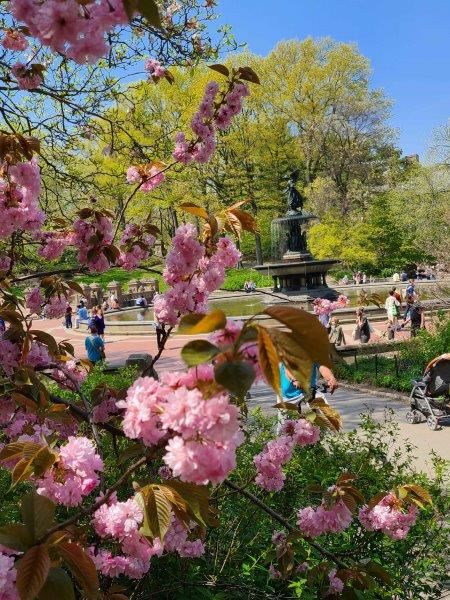
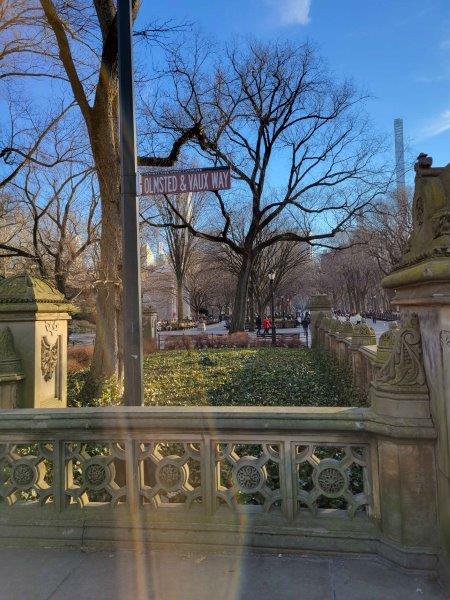
Strawberry Fields
Strawberry Fields is a peaceful memorial dedicated to John Lennon, located near the entrance of Central Park. The circular mosaic bears the word “Imagine” in the center, and is surrounded by flowers and trees. It is more than likely that you will find someone playing Beatles or John Lennon’s music here, and the Imagine mosaic is a classic Central Park landmark.
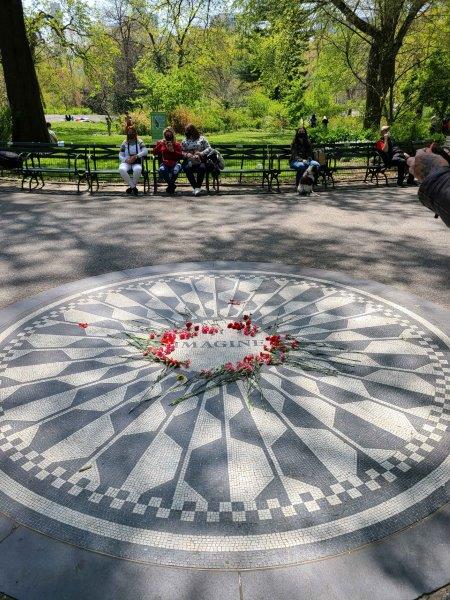
Shakespeare Garden
The Shakespeare Garden is a beautiful and serene garden that is home to a variety of plants mentioned in Shakespeare’s plays. There are excerpts from his writings featuring the various flowers that are feaured in the garden. It is amazing to visit in the spring with cherry blossoms and tulips in full bloom. A lesser known fact about the Shakespeare Garden is that it has a Whispering Bench tucked away at the top of it.
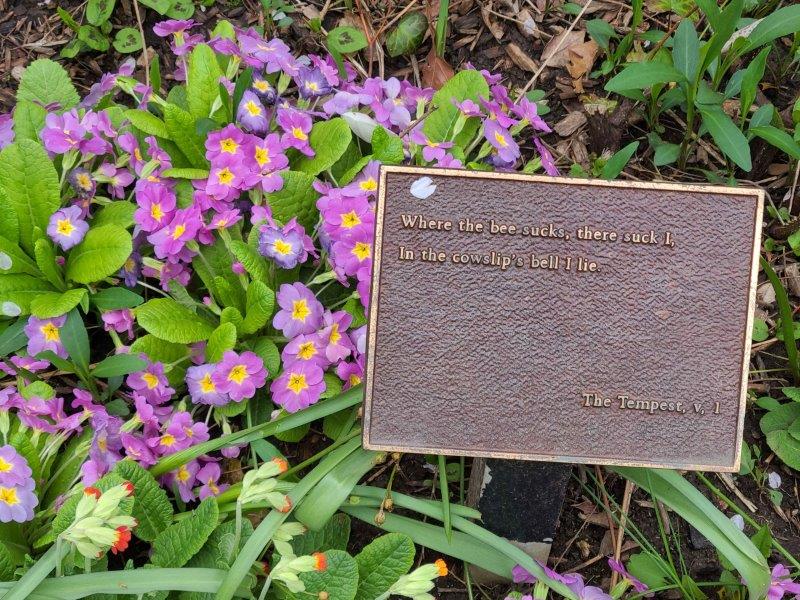
Bow Bridge
Bow Bridge is the most photographed location in Central Park for good reason. The cast iron bridge spans across the lake and offers stunning views of the Manhattan skyline. It is beautiful in any weather, and views of and from Bow Bridge are memorable.
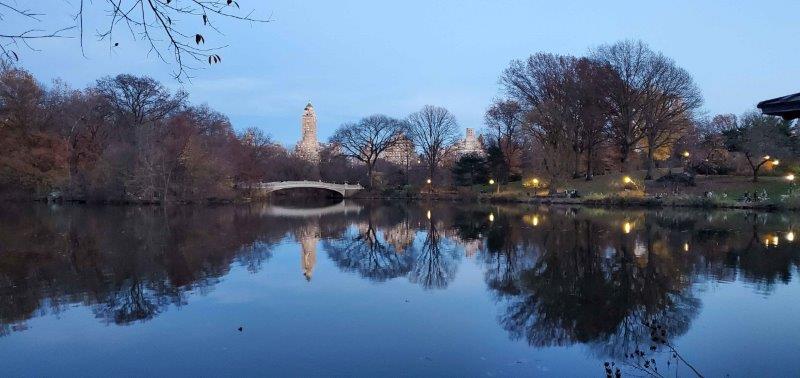
Belvedere Castle
Belvedere Castle is a small castle located on a hill in the middle of the park. Visitors can climb to the top of the castle and enjoy panoramic views of the park and the city. The castle also houses a small nature center, where visitors can learn about the flora and fauna of Central Park. NYC’s weather station is actually located in Belvedere Castle since 1920.
The Mall
The Mall is a wide promenade lined with American elm trees that leads to the Bethesda Terrace. It is the only stratight path in Central Park by design. The south end of the Mall is lined with statues of notable people including William Shakespeare, Sir Walter Scott, and Robert Burns among others. In 2020, the first statue of real life women was added as the Women’s Rights Pioneers Monument, the first in 50 years. The Mall is a popular place to watch street performers and artists.
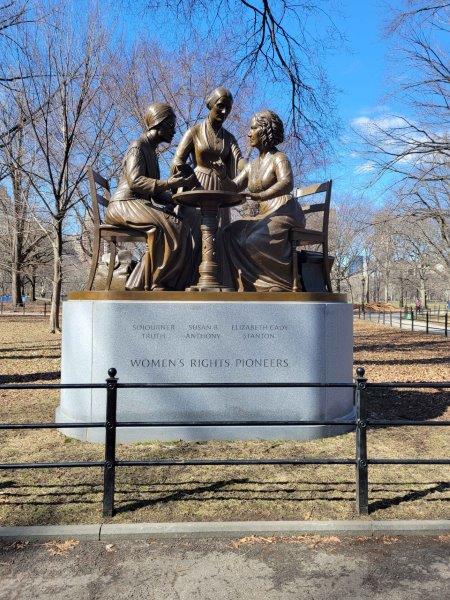
Central Park Zoo
The Central Park Zoo is a small zoo located near the southeast corner of the park. Visitors can see a variety of animals, including penguins, sea lions, and monkeys. The zoo also houses a children’s zoo, where kids can interact with goats, sheep, and pigs. The Central Park Zoo also has the Delcorte Clock, which has musical animals that turn every 30 minutes.
Jacqueline Kennedy Onassis Reservoir
The Jacqueline Kennedy Onassis Reservoir is a large body of water located in the northern part of the park. It has a track around it for walking and jogging, and offers some of the best views of the skyscrapers from Central Park. The reservoir is also a popular spot for bird-watching, and for catching the cherry blossoms in spring.
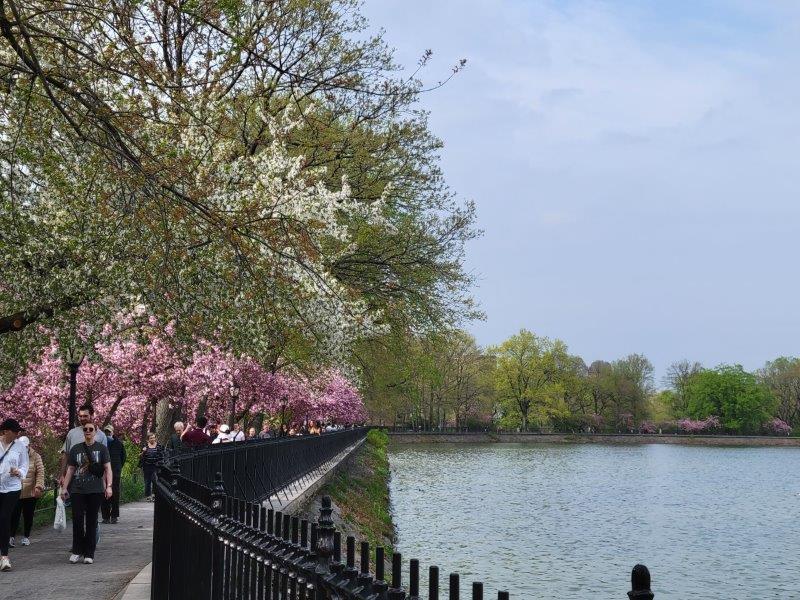
Ladies Pavilion
The Ladies Pavilion is a charming and historic cast-iron shelter located along the Central Park Lake. This Victorian-style structure, nestled at the edge of the Lake in the Ramble, exudes a picturesque and romantic ambiance that is a popular vantage point to see the water and the landscape.
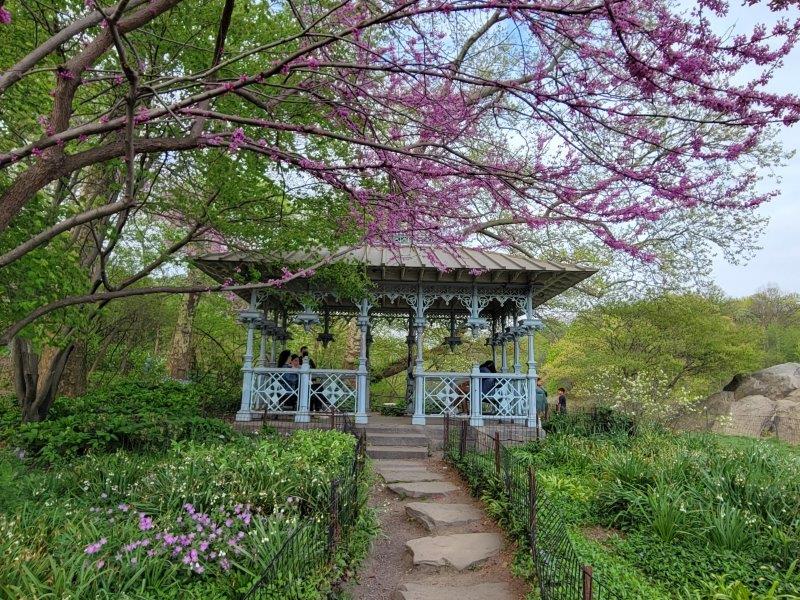
Recreational Areas
Central Park is home to many recreational areas, including playgrounds, ball fields, and skating rinks. Two of the most notable lawns are the Great Lawn and Sheeps Meadow. Visitors can enjoy a game of baseball, basketball, or soccer, or take a spin around the ice rink in the winter. There are also many picnic areas throughout the park, making it the perfect spot for a family outing or a romantic picnic.
Secrets of Central Park
Central Park is full of secrets that are hidden in plain sight if you know where to look. Here are a few.
Original Bolt
In 1881, when Manhattan was being mapped out as a grid, there were bolts used to make the locations of cross streets. One of these original survey bolts used to map out the park can be found in Central Park, though its location is not publicized. Those in the know can find it as it is hiding in plain sight in a busy section of Central Park.
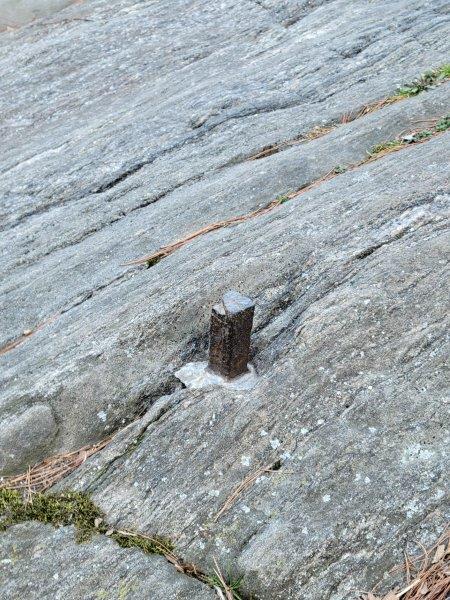
Lamp Post Code
Another secret of Central Park is the lamp post code. Each lamp post in the park has a code on it that tells you exactly where you are in the park. The first two or three numbers tell you the nearest street, while the last two numbers indicate if you are on the east side of the park if they are even, and on the west side if they are off. For example, if you see a lamp post with the code “7112,” you know you are near 71st Street and on the east side. This system makes it easy to navigate the park and find your way around.

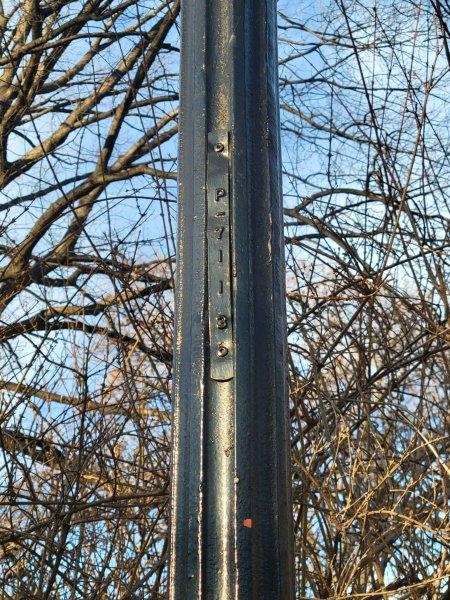
Crabs below Obelisk
Cleopatra’s Needle, an ancient Egyptian obelisk, stands prominently across from the Metropolitan Museum on the East side of Central Park. Transported to New York in the 19th Century, the base of the obelisk has weathered over time and is supported by bronze crabs. Despite being overshadowed by the obelisk’s grandeur, the crabs can be spotted at the base upon closer inspection.
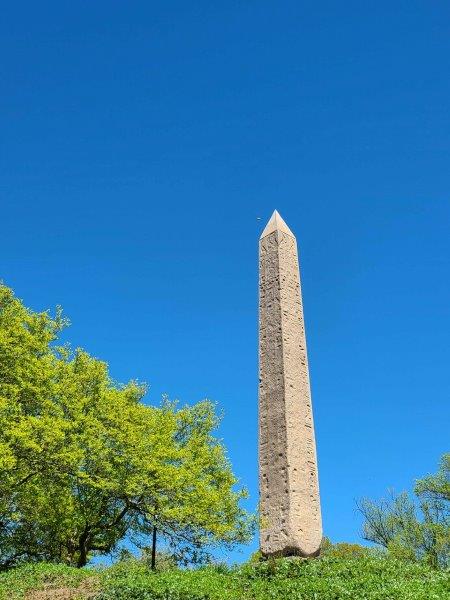
Central Park in Different Seasons
Central Park is a natural oasis in the midst of Manhattan which is beautiful and unique in each season, offering a different experience every time you visit. Here are some of the highlights of Central Park in each season.
Winter
Winter in Central Park is a magical experience, especially after a snowfall when it is covered in a blanket of snow and ice, creating a serene and peaceful atmosphere. Winter is a time for ice skating at Wollman Rink or Lasker Rink, both of which offer stunning views of the city skyline. All of Central Park becomes a playground suitable for sledding after a snowfall, especially if a snow day has been declared in schools. Central Park even has a secret pet memorial Christmas Tree that makes an appearance in the Ramble every winter.
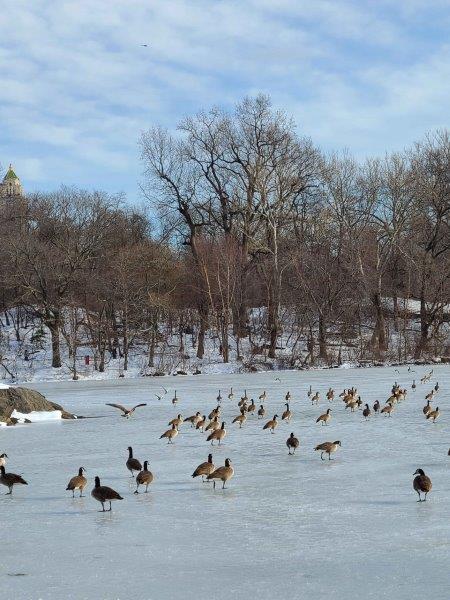
Summer
Summer is one of the best seasons to visit Central Park as visitors can happily enjoy all of the outdoor attractions in the park. The park is bustling with activity, and visitors can enjoy a picnic in Sheep Meadow or Great Lawn, the perfect picnic spots in the park. There are also several concerts and events held in the park during the summer months, including Shakespeare in the Park and SummerStage.
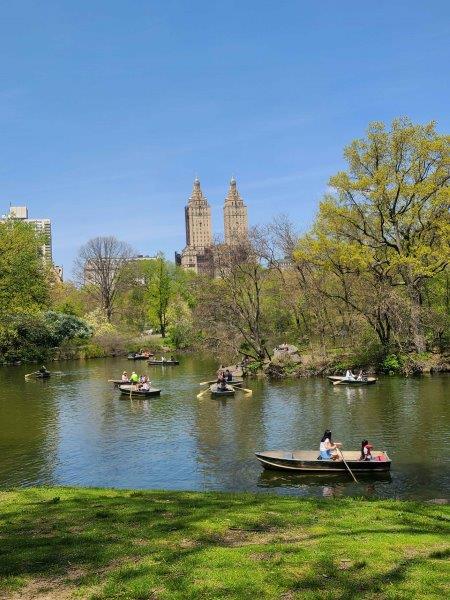
Spring
Spring is a beautiful time to visit Central Park as the park comes alive with blooming flowers and trees. The park’s Conservatory Garden is especially beautiful in the spring, with its vibrant cherry blossoms, tulips and other flowers. It is the perfect time to enjow a walk along the park’s many paths and trails, taking in the fresh spring air and the beautiful scenery.

Autumn
Autumn is a popular time to visit Central Park as the leaves on the trees begin to change color, creating a stunning display of fall foliage. Central Park has a foliage tracker to find the best places to catch peak foliage in Central Park.

Conservation
Central Park is not only a beautiful place to visit, but it is also a place where conservation efforts are in place to protect the park’s wildlife and vegetation. The Central Park Conservancy is responsible for maintaining and preserving the park’s natural resources.
Wildlife
Central Park is home to a diverse range of wildlife, including birds, mammals, reptiles, and amphibians. Some of the most commonly spotted animals in the park include raccoons, squirrels, skunks, and birds such as the American Robin and the Northern Cardinal. Visitors are encouraged to observe the wildlife from a distance and not to feed or disturb them.
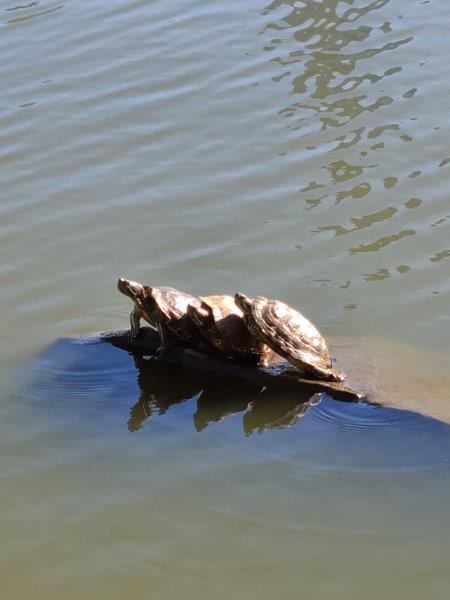
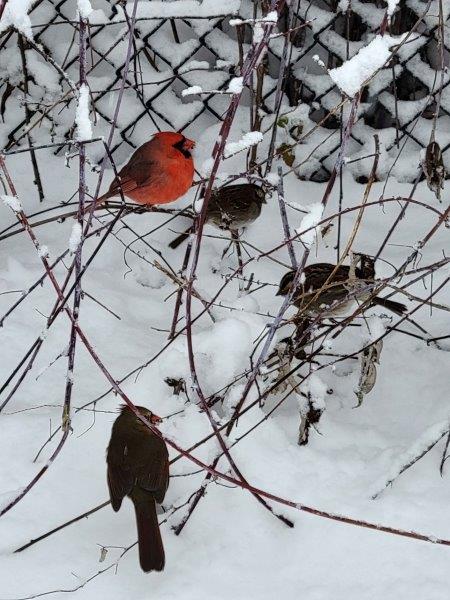
Vegetation
The park’s vegetation is just as important as its wildlife. Central Park has over 20,000 trees, including oak, maple, and elm trees. The park also has a variety of plants and flowers, such as cherry blossoms, daffodils, and tulips. The Central Park Conservancy is responsible for maintaining the park’s vegetation and ensuring that it remains healthy and vibrant.
Conservancy Efforts
The Central Park Conservancy is committed to preserving and protecting the park’s natural resources. The Conservancy’s efforts include planting new trees and plants, removing invasive species, and restoring damaged areas. In addition, the Conservancy works to educate visitors about the importance of conservation and how they can help protect the park’s natural resources.
To achieve these goals, the Conservancy has a team of experts who work year-round to maintain the park’s natural resources. The team includes horticulturists, ecologists, and arborists who work together to ensure that the park remains healthy and vibrant for generations to come.
Overall, the conservation efforts in Central Park are a testament to the importance of preserving and protecting our natural resources. The Central Park Conservancy’s work ensures that the park remains a beautiful and vibrant oasis in the heart of New York City.
Central Park Benches and their Endowment
Central Park is home to more than 10,000 benches, each with a unique design and history. These benches offer a place of respite and reflection for visitors, providing a space to take in the beauty of the park and its surroundings.
To ensure the maintenance and preservation of these benches, the Central Park Conservancy established the Adopt-A-Bench program in 1986. This program allows individuals to donate funds to endow the care of a specific bench, ensuring it remains in good condition for years to come.
To date, more than 8,000 benches have been adopted through this program, providing crucial support for the ongoing maintenance and restoration of Central Park’s benches. Donors can choose to have a plaque installed on their adopted bench, featuring a personalized message or dedication. I actually have a bench of my own in Central Park!
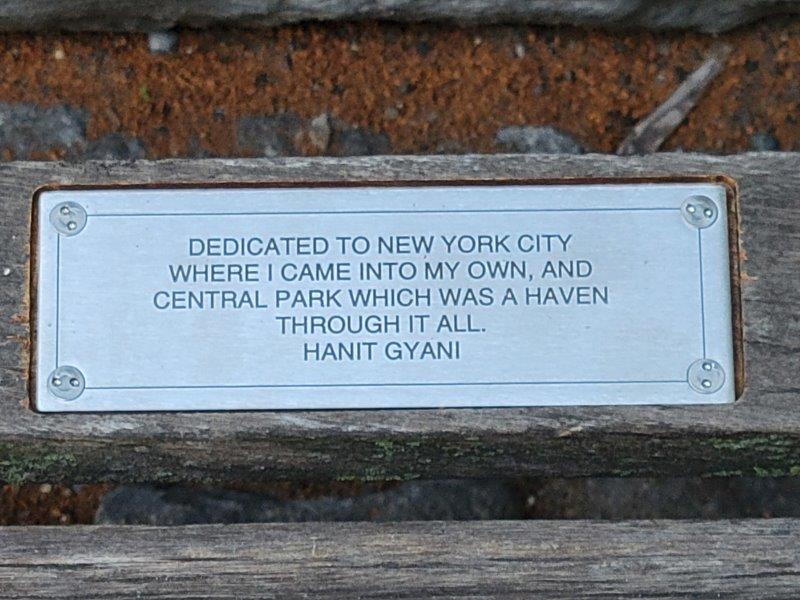
Visitor Information
Central Park is one of the most visited parks in the world and attracts millions of visitors every year. Whether you are a New Yorker or a tourist, there are a few things you should know before visiting the park. Here is some visitor information that will help you make the most of your visit.
Hours
Central Park is open daily from 6:00 am to 1:00 am. The park is a popular destination, so it is always busy, but the crowds are usually smaller in the early morning and late at night. Some areas of the park have different opening and closing times, so it is best to check the official Central Park website for specific information. It is advisable to visit Central Park after dark as part of a group, or for an organized event.
Visiting at Night
Central Park is open late, and visiting the park at night needs to be done with caution. Some areas of the park may be closed or have limited access after dark. It is also important to keep safety first and stay in well-lit areas and to be aware of your surroundings.
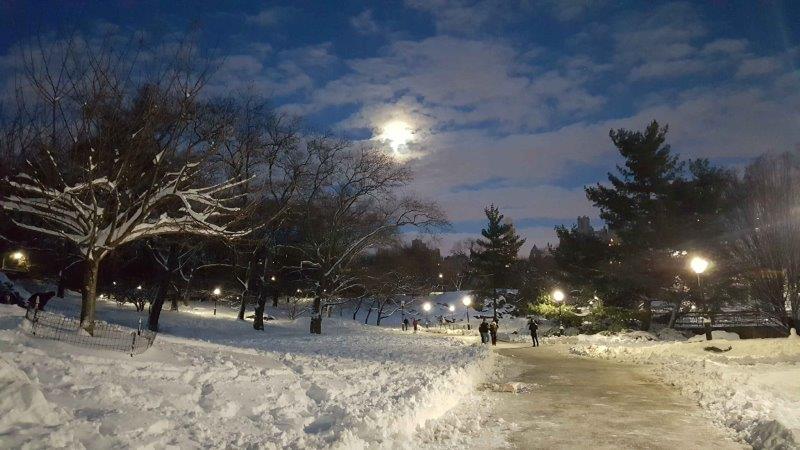
Events and Activities
Central Park hosts a variety of events and activities throughout the year. Visitors can enjoy concerts, festivals, and cultural events, as well as sports and recreational activities such as ice-skating, boating, and horseback riding. The park is also home to several attractions, including the Central Park Zoo, the Conservatory Garden, and the Great Lawn, and annual events such as Shakespeare in the Park and New York Philharmonic in the Park. The annual New York City Marathon ends in Central Park, making it a great time to visit and cheer the runners on.
Rules and Regulations
Central Park has several rules and regulations that visitors should be aware of.
- Driving in Central Park is not permitted.
- Smoking is prohibited in all areas.
- The Central Park loop has one direction for bicyclists, though it can be navigated in either direction if you are running or walking.
- Bicycles are allowed on designated paths, and visitors must yield to pedestrians.
- Visitors should also be aware of the park’s wildlife and should not feed or disturb the animals.
- Dogs are permitted in most areas, and are required to be on leash 9:00 am – 9:00 pm. Off-leash hours for dogs are 6:00 am – 9:00 am and 9:00 pm – 1:00 am, though they are required to be on leash at all hours in designated areas.
- Drones are not permitted.
- Barbequeing is not permitted in most areas. It is permitted only on these specific days, which does not include the weekend – Memorial Day, Labor Day and 4th of July.
Transportation in Central Park
Central Park is best experienced by walking or running.
Central Park is a large park, and visitors are permitted limited transportation options which include biking, horse-drawn carriage rides, and pedicabs.
Frequently Asked Questions
What are the top attractions to visit within Central Park?
Central Park is home to many popular attractions, including the Central Park Zoo, the Conservatory Garden, the Great Lawn, and the Bethesda Fountain. Visitors can also explore the various walking trails, lakes, and bridges that make Central Park an iconic destination in New York City.
How can I find a map of Central Park?
The official Central Park website provides detailed maps that includes all of the park’s major attractions online, or at the various information kiosks located throughout the park.
What is the history behind the creation of Central Park?
Central Park was designed by Frederick Law Olmsted and Calvert Vaux in the mid-19th century as a way to provide New Yorkers with a peaceful retreat from the hustle and bustle of city life. The park was officially opened in 1858 and has since become one of the most popular urban parks in the world.
Where is the Central Park Zoo located and what can I expect to see there?
The Central Park Zoo is located near the southeast corner of the park and is home to a wide variety of animals, including penguins, sea lions, and snow leopards. Visitors can also explore the Tisch Children’s Zoo, a petting zoo that allows children to interact with domestic animals.
What are some free activities to enjoy in Central Park?
Central Park offers a variety of free activities for visitors, including walking tours, bird watching, outdoor concerts, Shakespeare in the Park and New York Philharmonic in the Park. Visitors can also explore the park’s many walking trails and picnic areas.
How much time should I allocate for a walk through Central Park?
The amount of time needed to explore Central Park depends on the visitor’s interests and the attractions they wish to see. A leisurely walk through the park can take several hours, while a quick visit to a specific attraction can be done in less than an hour.
Can you drive in Central Park?
Central Park is closed to vehicular traffic. Visitors looking for options other than walking can rent a bike, pedicab or take a horse-drawn carriage ride to explore the park in a unique way.
Can you drink alcohol in Central Park?
No, drinking alcohol is not permitted in Central Park.
Can you smoke in Central Park?
No, smoking is not permitted in Central Park.
Is Central Park safe at night?
While Central Park is open till 1am every night, as a New Yorker I tend not to frequent Central Park after dark, unless it is with a group of people or to attend an organized event that has a lot of attendees.

